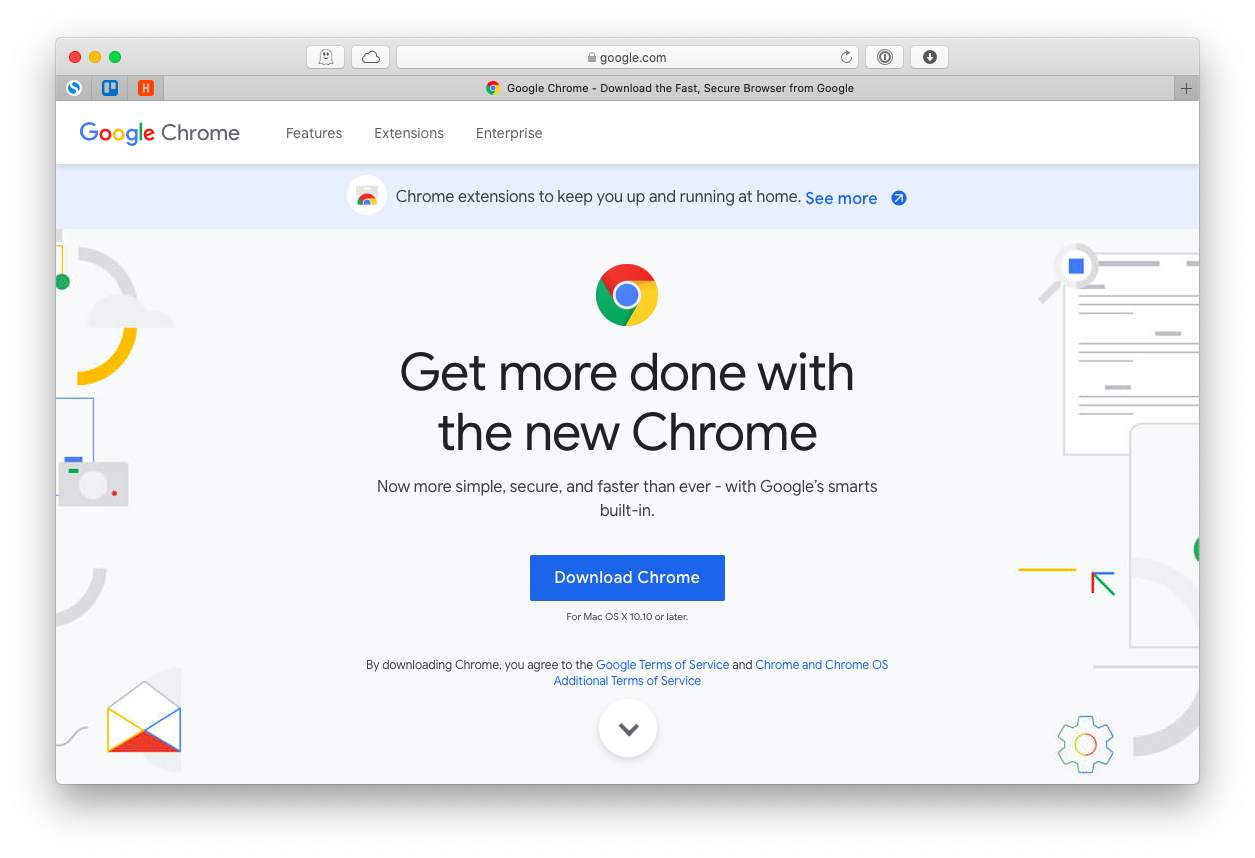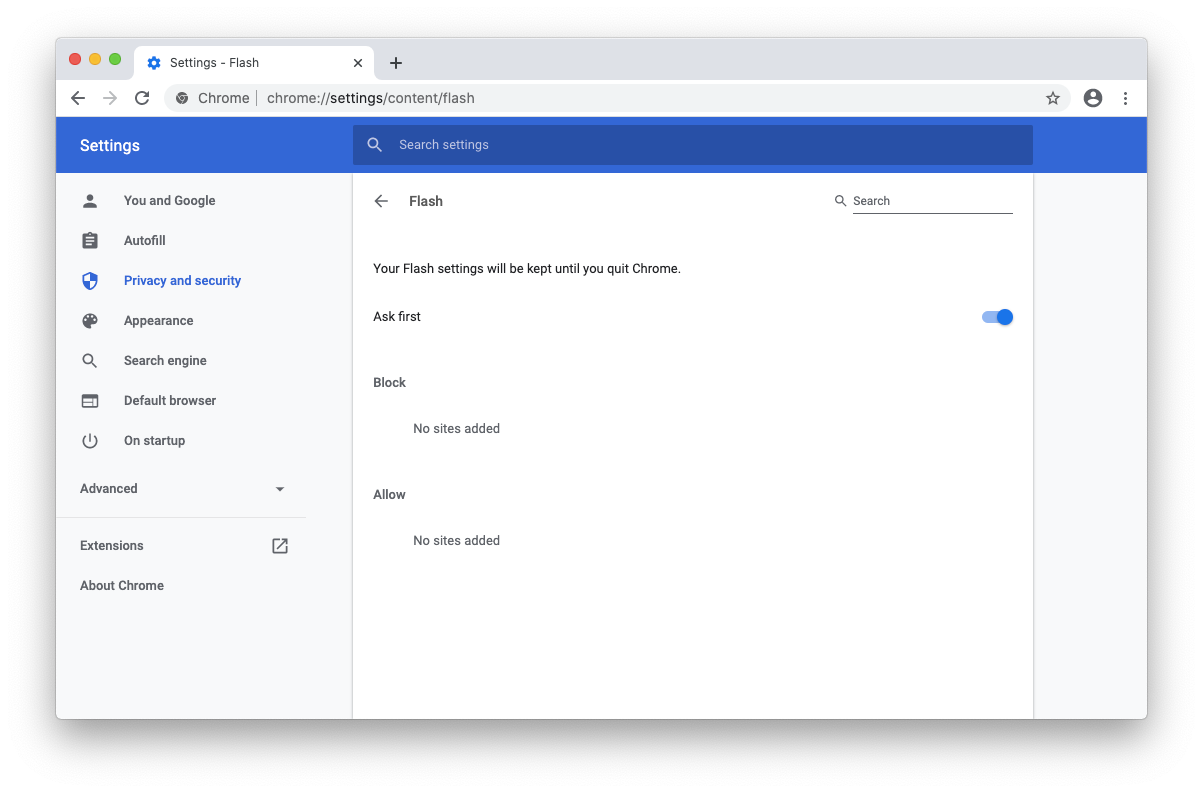Mac Chrome Flash
The world's number 1 browser

There’s nothing wrong with Chrome, or the sound, but it just wasn’t working. After some digging, I figured out that it is just Flash related. Turns out, the real problem is a conflict between the built-in Flash plugin in Chrome, and the Adobe one that I must have downloaded elsewhere. And the solution is to remove one of them. Nov 12, 2020 Launch Chrome, click the three dots at the top-right corner, and select Settings. Select Privacy and security on the left and click Site settings on the right. Scroll down and click Flash. Turn the toggle that says Block sites from running Flash (recommended) to the ON position.
- The solution, disable windows update, uninstall chrome, firefox, flash, AVG (avg antivirus was downloading the latest version of chrome and flash for me lol), uninstall all the automated crap. Install firefox 47. Install flash 22. Edit mms.cfg to turn of autoupdate for flash NPAPI.
- Google Chrome for Mac has a laundry list of features, earning its spot as the top web browser of choice for both Mac and PC users. It offers thousands of extensions, available through the Chrome web store, providing Mac owners with even more functionality. Adobe Flash is also available when you install Chrome on your Mac.
Google Chrome is the most widely used web browser in the world. Users enjoy its fast loading speed, cross-device integration, and tabbed browsing. Google Chrome does not come installed as a standard on new Macs or PCs. Their native web browsers (Safari and Microsoft Edge, respectively) are automatically installed, forcing users to install Chrome themselves.
Seamless internet navigation
Chrome is an ideal browser to enjoy easy, coordinated online browsing across various devices.
Whether you have a new Mac or an older one, Google Chrome sets the bar high for web browsers. You want a browser that is safe, easy to use, syncs data and content across all your devices, and operates quickly. Google Chrome is the solution that over 63% of the world turns to and with good reason. Mac users have distinguished taste and as such, expect high quality in their hardware and software products. Google Chrome delivers this to Mac users with its low CPU usage, reliability, and overall browsing experience. It delivers a high-quality browsing experience to Mac users with its low CPU usage, reliability, tabbed browsing, cross-device syncing, and lighting fast loading speed.
Google Chrome for Mac has a laundry list of features, earning its spot as the top web browser of choice for both Mac and PC users. It offers thousands of extensions, available through the Chrome web store, providing Mac owners with even more functionality. Adobe Flash is also available when you install Chrome on your Mac. The overall appearance is professional and clean. Enjoy customized browser preferences including your homepage of choice, sync and Google services, Chrome name and picture, importing bookmarks and settings, autofill capabilities (passwords, payments, addresses, etc.), toolbars, font, page zoom, and startup settings. Chrome’s user interface is incredibly easy to navigate. Multi-tasking just got easier with tabbed browsing, which not only helps productivity, but looks clean and organized. Since Chrome can be downloaded on all of your devices (computers, phones, tablets), if you open a browser or perform a search on one device, Chrome will auto-sync that work stream on your other devices. If you look up a dinner recipe at work on your Mac but need the ingredient list at the grocery store? No problem - pull up the same tab within Chrome on your iPhone. Once you are home and ready to start cooking, just pull up the same Chrome recipe tab on your tablet. With the world moving faster than ever before, functionality like this can help make life a little easier.
Chrome’s password, contact information, and payment autofill capabilities are revolutionizing users’ online experience. Upon your consent, Chrome’s autofill feature will easily fill out your name, address, phone number, email address, passwords, and payment information. If it’s time to register your child for the soccer season but your wallet is downstairs, Google Chrome has your back, helping you easily fill in the data, so you can stay in your comfy chair. Chrome will only sync this data on your approved devices, so you can rest easy that your information is safe. CPU usage is immensely important when choosing a web browser. Keep your Mac’s CPU free by browsing with Google Chrome, maximizing overall system performance. Chrome for Mac is currently available in 47 languages. It can only be installed on Intel Macs, currently limiting its userbase. Mac users can manage how their browsing history is used to personalize search, ads, and more by navigating to their 'Sync Settings' within Chrome. Encryption options, auto-completion of searches and URLs, similar page suggestions, safe browsing, and enhanced spell check are also available within the settings tab, helping users feel more in control of their browsing experience. Users also have the option to 'help improve Chrome' by automatically sending usage statistics, crash reports, visited URLs, and system information to Google, or can easily opt out within Chrome’s settings.
Where can you run this program?
Google Chrome is available on MacOS X Yosemite 10.10 or later, Windows 7 or later, Android, and iOS devices. Chrome may successfully install on devices with lesser system requirements; however, Google only provides support on a system meeting the minimum system requirements.
Is there a better alternative?
For Mac users, Safari is the standard out-of-the-box browser installed on new devices. Most users prefer a web browser with better functionality than Safari. Chrome is harder on a Mac’s battery life than Apple’s native Safari browser. However, Chrome comes out ahead of Safari in terms of browsing speed, extensions, and video loading capabilities. Safari does have many of Chrome’s features such as tab syncing across devices and auto-filling based on previous searches. Mozilla Firefox is another commonly used web browser among Mac users, though its memory usage knocks it down on the list of competitors. The main draw to Mozilla Firefox over Chrome is that because Firefox is open source, nothing fishy is going on behind the scenes. Google is notorious for capturing and using data which rightfully makes people uncomfortable.
Our take
Mac users tend to do things their own way. You’ve opted for the non-mainstream computer hardware, so using the native installed Safari browser seems in character. Safari’s minimalist look draws Mac users in as well. Google Chrome is much more 'going along with the crowd'. Putting that aside, Mac owners should dig into what they really use their web browsers for, and determine if data privacy or features is more important to them. Better yet, why not have two browsers?
Should you download it?
Yes. For Mac users, Google Chrome’s quick speed and helpful features makes it an excellent web browser choice. Google’s controversial collection of personal and usage data is sure to make some pause on whether to install Chrome or not. However, if you are comfortable or indifferent to Google’s data collection, go for it; the browser's overall functionality is impressive.
Highs
- Fast loading speed
- Thousands of extensions available via the chrome web store
- Tabbed browsing synced across devices
- Convenient auto-fill
Lows
- Available on MacOS X Yosemite 10.10 or later
- Google’s aggressive data collection practices
Google Chromefor Mac
75.0.3770.100
Best apps live in Setapp
Having been around since 1996, Adobe Flash Player has played a crucial role in the evolution of the web. For the longest time, before HTML5 became truly widespread, it was the only effective way to run multimedia content online, including video, games, applications, audio, and more.
Today, the era of Adobe Flash Player is coming to an end. While the Flash Player 2020 is still supported, Adobe announced back in 2017 that 2020 would be the last year of support for the software. Accordingly, all major browsers, from Safari to Firefox and Chrome, replaced most of Flash Player’s functionality with compatible HTML5 features. What’s more, Microsoft said it would completely remove Flash from its browsers at the end of 2020.
So why has the internet, which benefited so much from everything that Flash had to offer, suddenly turned against it? In a word, it had a lot to do with security issues and the closed ecosystem of Adobe.
Why Is Adobe Flash Player Going Away?
In his 2010 letter, Thoughts on Flash, Steve Jobs outlined his reasons for Apple’s iOS devices not supporting the Flash standard, which arguably greatly accelerated its downfall. Jobs cited poor performance on mobile devices, frequent crashes, high battery consumption, and availability of better open standards (i.e. HTML5) that are able to completely replace Flash.

In reality, security vulnerabilities have plagued Adobe Flash Player throughout its life, and it has been widely reported to be the primary target for hackers trying to exploit those vulnerabilities, which companies producing browsers and operating systems couldn’t fix due to the proprietary nature of Flash.
Having said that, there are still quite a few reasons for why you might want to use Adobe Flash Player. For example, it could still be the only way some legacy media content on the web (e.g. videos, games) is going to play on your Mac. So let’s look at how to enable Adobe Flash Player in Chrome.
How to enable Adobe Flash Player on Chrome
If you need to use Flash Player today, your best bet is to go with Google Chrome. You might be surprised to hear that the Flash plugin is already installed in Chrome, however, it’s turned off by default — you need to turn on Flash in Chrome Flash settings yourself.
So how to allow Flash on Chrome?
Open Google Chrome and go to Settings (⌘ + ,)
Scroll down to “Privacy and security”
Click Site Settings ➙ Flash
By default, there’s a toggle set to the off position that says “Block sites from running Flash (recommended).” Switch it on, so it says “Ask first.”
Enable Adobe Flash Player In Google Chrome
Now, every time you visit a website that contains something for Flash Player Chrome will ask your permission to play it instead of blocking it. But your settings will only work until you quit Google Chrome. So don’t forget to come back and reset it after.
In case you’re having problems with the Chrome Flash Player, updating Google Chrome could help:
Open Chrome and click on the menu button in the top-right corner
Click Update Google Chrome, if available. Otherwise, you’re currently on the latest version.
Alternatively, visit google.com/chrome and download the latest version of Chrome from there
Remember that Google Chrome will stop the support for the Flash Chrome plugin at the end of 2020, so if you absolutely need to use it, make sure you stop Google Chrome from automatically updating sooner rather than later (and use another browser for day-to-day work). But how do you do that? It’s a bit more technical:
Launch Terminal from your Applications ➙ Utilities folder
Type defaults write com.google.Keystone.Agent checkInterval 0
Press Enter
Quit Terminal and relaunch Google Chrome
Note: This command will stop the general Google Software Update script from working, so none of your Google apps (e.g. Google Drive for Mac) will automatically receive updates.
To undo the change and let the Chrome browser update itself again:
Launch Terminal
Type defaults write com.google.Keystone.Agent checkInterval 10000
Press Enter
Quit Terminal and restart Google Chrome


How to block websites from using Adobe Flash
It’s likely that everyone who needs to run Adobe Flash Player for Chrome right now has a specific use case in mind, such as a retro online game or an old-school website. Practically no one needs to allow Flash in Chrome for all websites. So how do you block specific websites from accessing Flash? Although tedious, it’s fairly easy to do:
Open Google Chrome and visit any website
Click on the padlock icon in the far left of the URL bar
Select the Flash dropdown and choose Block. If you don’t see the dropdown, choose “Site settings” instead, then find Flash in the list and select Block from there.
How to update Adobe Flash Player for Chrome
Most of the time, when you enable Flash in Chrome, it’s going to be up to date. But, occasionally, you could see a Chrome enable Flash error. To resolve it, try updating your Adobe Flash Player Chrome edition first:

Google Chrome Flash Player Download
Open Chrome
Type chrome://components in the URL bar and hit Enter
Scroll down to Adobe Flash Player
Click “Check for update”
Alternatively, you can simply reinstall your Chrome Flash Player altogether:
Visit get.adobe.com/flashplayer/otherversions
Pick your OS from the dropdown
Select PPAPI as a version
Click Download Flash Player
Find and install the Adobe Flash Player for Chrome in your Downloads folder
Why scan your Mac for Adobe Flash malware?
It’s good to understand that every major browser is disabling the use of Adobe Flash for a reason — there are simply too many security flaws in the software. So if you consciously search for how to enable Flash in Chrome, you’re exposing yourself to some potential risk.
What you definitely need here is a powerful and trusted malware removal software, so that nothing is able to put your Mac or your files in danger. Where do you look for one?
CleanMyMac X is the world’s leading optimizer for Mac. It not only scans your Mac for every known type of malware and keeps its databases up to date but also helps you maintain your online privacy, speeds up your Mac overall, completely uninstalls any intrusive apps, deals with useless extensions, shreds outdate personal files, frees up space, and much more.
To see if any malware has infiltrated your Mac:
Launch CleanMyMac X
Navigate to the Malware Removal tab under Protection
Click Scan
Hit Remove, if any malware was found
Mac Chrome Flash
How to recover deleted files on Mac
After you learn how to enable Flash on Chrome, you should at least try to prepare for all eventualities. One of which is a possibility of losing some of your files to malware produced by the Adobe Flash Chrome plugin. How do you get those files back?
Disk Drill is a top-notch app for recovering any recently deleted file from your hard drive. It works for unintentionally removed files just as well as for disk utility errors or data corruption, both on your hard drive or any external devices connected to your Mac. Moreover, it features a handy backup functionality (a good habit to have) so you can save your files somewhere safe frequently with 100% recovery rate.
To use Disk Drill:
Launch the app
Connect your external drive or pick the internal driver from the list and click Recover
Wait for the scan to finish and select the files you want to get back
So if you need to use Flash today, having an Adobe Flash Player Chrome plugin is probably your best bet. Just make sure to stop your Google Chrome from updating to keep using Flash past 2020 and install a malware removal app like CleanMyMac X and a data recovery software like Disk Drill beforehand, just in case.
How To Allow Flash On Mac Chrome
Best of all, CleanMyMac X and Disk Drill are available to you absolutely free for seven days via Setapp, a platform with more than 200 Mac apps for any situation, from bill payments (Chronicle) to extracting files (Archiver) to keeping contacts in one place (BusyContacts). Try them all today at no cost and see for yourself!
Meantime, prepare for all the awesome things you can do with Setapp.
Read onSign Up
Mac Chrome Adobe Flash Player Is Blocked
